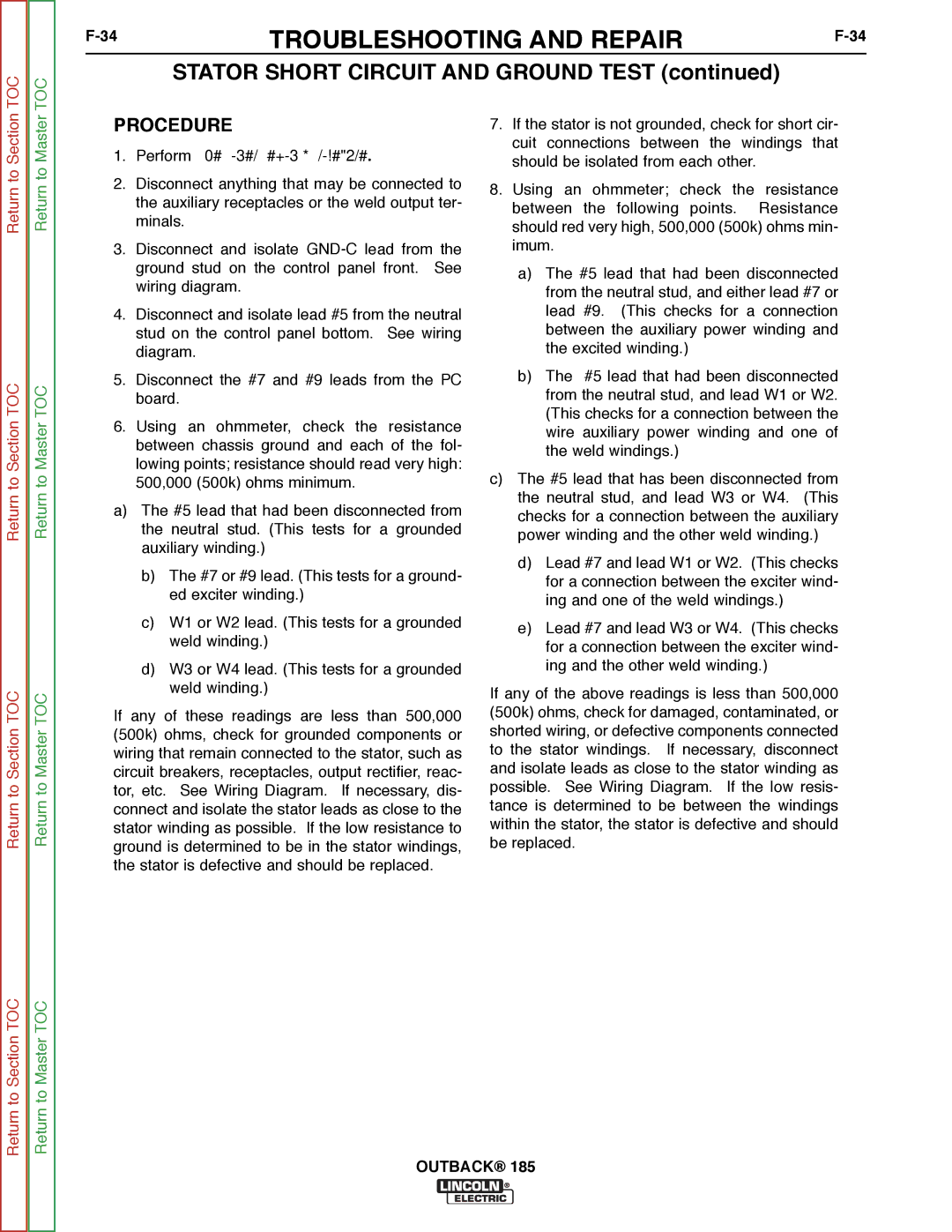
TOC
TOC
TROUBLESHOOTING AND REPAIR | ||
|
STATOR SHORT CIRCUIT AND GROUND TEST (continued)
Return to Section
Return to Section TOC
Return to Section TOC
Return to Section TOC
Return to Master
Return to Master TOC
Return to Master TOC
Return to Master TOC
PROCEDURE
1.Perform Case Cover Removal Procedure.
2.Disconnect anything that may be connected to the auxiliary receptacles or the weld output ter- minals.
3.Disconnect and isolate
4.Disconnect and isolate lead #5 from the neutral stud on the control panel bottom. See wiring diagram.
5.Disconnect the #7 and #9 leads from the PC board.
6.Using an ohmmeter, check the resistance between chassis ground and each of the fol- lowing points; resistance should read very high: 500,000 (500k) ohms minimum.
a)The #5 lead that had been disconnected from the neutral stud. (This tests for a grounded auxiliary winding.)
b)The #7 or #9 lead. (This tests for a ground- ed exciter winding.)
c)W1 or W2 lead. (This tests for a grounded weld winding.)
d)W3 or W4 lead. (This tests for a grounded weld winding.)
If any of these readings are less than 500,000 (500k) ohms, check for grounded components or wiring that remain connected to the stator, such as circuit breakers, receptacles, output rectifier, reac- tor, etc. See Wiring Diagram. If necessary, dis- connect and isolate the stator leads as close to the stator winding as possible. If the low resistance to ground is determined to be in the stator windings, the stator is defective and should be replaced.
7.If the stator is not grounded, check for short cir- cuit connections between the windings that should be isolated from each other.
8.Using an ohmmeter; check the resistance between the following points. Resistance should red very high, 500,000 (500k) ohms min- imum.
a)The #5 lead that had been disconnected from the neutral stud, and either lead #7 or lead #9. (This checks for a connection between the auxiliary power winding and the excited winding.)
b)The #5 lead that had been disconnected from the neutral stud, and lead W1 or W2. (This checks for a connection between the wire auxiliary power winding and one of the weld windings.)
c)The #5 lead that has been disconnected from the neutral stud, and lead W3 or W4. (This checks for a connection between the auxiliary power winding and the other weld winding.)
d)Lead #7 and lead W1 or W2. (This checks for a connection between the exciter wind- ing and one of the weld windings.)
e)Lead #7 and lead W3 or W4. (This checks for a connection between the exciter wind- ing and the other weld winding.)
If any of the above readings is less than 500,000 (500k) ohms, check for damaged, contaminated, or shorted wiring, or defective components connected to the stator windings. If necessary, disconnect and isolate leads as close to the stator winding as possible. See Wiring Diagram. If the low resis- tance is determined to be between the windings within the stator, the stator is defective and should be replaced.
